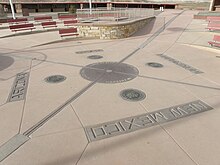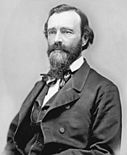Portal:Colorado
The Colorado Portal


WikiProject Colorado
You need not be either an expert or a resident.
You only need an active interest in the Centennial State.
Request an article about a Colorado topic here or volunteer here.
Colorado Events
- Wikimedia US Mountain West Spring 2024 online meeting, Tuesday, May 14, 2024, 8:00-9:00 PM MDT
- Wikimedia US Mountain West Summer 2024 online meeting, Tuesday, August 13, 2024, 8:00-9:00 PM MDT
- Wikimedia US Mountain West Autumn 2024 online meeting, Tuesday, November 12, 2024, 8:00-9:00 PM MST
Previous events:
|
|---|
Colorado events
|
Colorado Facts
- Date admitted to Union: August 1, 1876 (38th State)
- Demonym: Coloradan
- Capital: Denver
- Elected state officers:
- Governor: Jared Polis (D) (2019–)
- Lieutenant Governor: Dianne Primavera (D) (2019–)
- Secretary of State: Jena Griswold (D) (2019–)
- Treasurer: Dave Young (D) (2019–)
- Attorney General: Phil Weiser (D) (2019–)
- Colorado General Assembly:
- Colorado Senate:
- D-23 R-12 (2023–2024}
- Colorado House of Representatives:
- D-46 R-19 (2023–2024}
- Colorado Senate:
- Colorado Supreme Court:
- Brian Boatright, Chief Justice (2021–)
- Monica Márquez (2010-)
- William Hood, III (2014–)
- Richard Gabriel (2015–)
- Melissa Hart (2017–)
- Carlos Samour, Jr (2018–)
- Maria Berkenkotter (2021–)
- U.S. Senators:
- Class 2. John Hickenlooper (D) (2021–)
- Class 3. Michael Bennet (D) (2009–)
- 1. Diana DeGette (D) (1997–)
- 2. Joe Neguse (D) (2019–)
- 3. Lauren Boebert (R) (2021–2025)
- 4. vacant
- 5. Doug Lamborn (R) (2007–2025)
- 6. Jason Crow (D) (2019–)
- 7. Brittany Pettersen (D) (2023-)
- 8. Yadira Caraveo (D) (2023–)
- Total area: 104,094 square miles (269,602 km2) (eighth most extensive state)
- Highest elevation: Mount Elbert 14,440 feet (4,401.2 m) (third highest state)
- Mean elevation: 6,800 feet (2,070 m) (highest state)
- Lowest elevation: Arikaree River 3,317 feet (1,011 m) (highest state)
- Population (2020 census): 5,773,714 (21st most populous state)
- Population density: 55.47 per square mile (21.40 km−2) (39th most densely populated state)
- Number of counties: 64 counties (including two consolidated city and county governments)
- Number of municipalities: 273 municipalities, comprising 2 consolidated city and county governments, 73 cities, and 198 towns
- Time zone: MST=UTC−07, MDT=UTC−06
- USPS code: CO
- ISO 3166 code: US-CO
- Adjacent U.S. states: Wyoming, Nebraska, Kansas, Oklahoma, New Mexico, Arizona, Utah (tied for third most)
- State government website: Colorado.gov
- State tourism website: Colorado.com
State Symbols
Subcategories
The Colorado River (Spanish: Río Colorado) is one of the principal rivers (along with the Rio Grande) in the Southwestern United States and in northern Mexico. The 1,450-mile-long (2,330 km) river, the 5th longest in the United States, drains an expansive, arid watershed that encompasses parts of seven U.S. states and two Mexican states. The name Colorado derives from the Spanish language for "colored reddish" due to its heavy silt load. Starting in the central Rocky Mountains of Colorado, it flows generally southwest across the Colorado Plateau and through the Grand Canyon before reaching Lake Mead on the Arizona–Nevada border, where it turns south toward the international border. After entering Mexico, the Colorado approaches the mostly dry Colorado River Delta at the tip of the Gulf of California between Baja California and Sonora.
Known for its dramatic canyons, whitewater rapids, and eleven U.S. National Parks, the Colorado River and its tributaries are a vital source of water for 40 million people. An extensive system of dams, reservoirs, and aqueducts divert almost its entire flow for agricultural irrigation and urban water supply. Its large flow and steep gradient are used to generate hydroelectricity, meeting peaking power demands in much of the Intermountain West. Intensive water consumption has dried up the lower 100 miles (160 km) of the river, which has rarely reached the sea since the 1960s. (Full article...)Selected mountain -
The highest summit of the Rocky Mountains of North America and the entire Mississippi River drainage basin.
Selected biography -
Gilpin served as the first governor of the Colorado Territory. His administration was consumed largely with the defense of the new territory in the early days of the American Civil War and was brought down after only one year by scandalous financial dealings. After the demise of his political career, he made a large fortune as a land speculator in New Mexico, although his dealings were questionable and possibly illegal. (Full article...)
Selected article -

State Highway 74 (SH 74) is a state highway in the U.S. state of Colorado. Running 18 miles (29 km) from Interstate 70 (I-70) in El Rancho to SH 8 in Morrison, the highway roughly follows a hook-shaped path running northwest–southeast. The section of the route north of the town of Evergreen is known as Evergreen Parkway and is a segment with a four- to six-lane roadway, with the section east of Evergreen mostly two lanes. The other section is known as the Bear Creek Canyon Scenic Mountain Drive, or just Bear Creek Road, and primarily parallels Bear Creek, passing through the towns of Kittredge and Idledale. The route, which is on the outskirts of Denver, passes through several of the city's mountain parks, including Bergen, Dedisse and Red Rocks parks.
An early road following the current path was established in the late 19th century for miners and loggers. As floods ravaged the road along Bear Creek through the early 20th century, measures were taken to prevent further damage. Other sites along Bear Creek, such as a Civilian Conservation Corps (CCC) camp in Red Rocks Park and the Bear Creek Canyon Scenic Mountain Drive, as the section between Idledale and Morrison is called, have given the route a listing on the National Register of Historic Places. An early designation of the route number went further west than its current-day designation; that section was truncated by the late 1930s. Another eastern segment was added from Morrison east toward Denver in the 1940s, but that section too was removed. Newer improvements to the road include widening the Evergreen Parkway segment to four lanes and constructing an interchange with I-70. (Full article...)Selected image -
National Parks in Colorado
The 23 national parks in Colorado:
- Amache National Historic Site
- Arapaho National Recreation Area
- Bent's Old Fort National Historic Site
- Black Canyon of the Gunnison National Park
- Browns Canyon National Monument
- Camp Hale-Continental Divide National Monument
- Canyons of the Ancients National Monument
- Chimney Rock National Monument
- Colorado National Monument
- Continental Divide National Scenic Trail
- Curecanti National Recreation Area
- Dinosaur National Monument
- Florissant Fossil Beds National Monument
- Great Sand Dunes National Park and Preserve
- Hovenweep National Monument
- Mesa Verde National Park and World Heritage Site
- Old Spanish National Historic Trail
- Pony Express National Historic Trail
- Rocky Mountain National Park
- Sand Creek Massacre National Historic Site
- Santa Fe National Historic Trail
- Yucca House National Monument
Interesting facts-

- The Four Corners is the only place where four U.S. states meet.
- Native peoples, Spain, France, the United States, Mexico, the Republic of Texas, and the State of Deseret have claimed various portions of the present State of Colorado.
- In antiquity, the area of the Front Range Urban Corridor was a popular migration route for Paleoamericans.
- Today, the Front Range Urban Corridor is the home of more than five million people.
- Denver is one of the few cities in the world with both a police department and a sheriff's department.
- Denver is the only world city to accept and later reject an Olympic Games for environmental reasons.
- Denver is the home of the Great American Beer Festival, the National Western Stock Show, the People's Fair, and the Festival of Mountain and Plain.
Did you know (auto-generated) -

- ... that Charles Johnson received the most votes for student body president at the University of Colorado Boulder, even though he had already been disqualified from running?
- ... that Aymara legislator Rafael Quispe's humorous style of political activism led one Bolivian parliamentarian to describe him as the "Chapulín Colorado" of the Legislative Assembly?
- ... that some members of the Daughters of the American Revolution came up with the idea to design a flag of Colorado, unaware that such a flag already existed?
- ... that the No. 1–ranked 2023 Colorado Mines Orediggers, "college football's nerdiest contender", featured players with pigtails and a drawn-on blue mustache, a friar's haircut, and Harry Potter cosplay?
- ... that Parkville lost out on becoming the Colorado Territory's capital by eleven votes and is now a ghost town largely buried under mining waste?
- ... that Yemi Mobolade is the first Black person and the first non-Republican to be elected the mayor of Colorado Springs, Colorado?
- ... that the 1976 Big Thompson River flood took place several hours before Colorado's 100th anniversary of statehood?
Related WikiProjects
Related portals
Resources
Associated Wikimedia
The following Wikimedia Foundation sister projects provide more on this subject:
-
Commons
Free media repository -
Wikibooks
Free textbooks and manuals -
Wikidata
Free knowledge base -
Wikinews
Free-content news -
Wikiquote
Collection of quotations -
Wikisource
Free-content library -
Wikiversity
Free learning tools -
Wikivoyage
Free travel guide -
Wiktionary
Dictionary and thesaurus






















